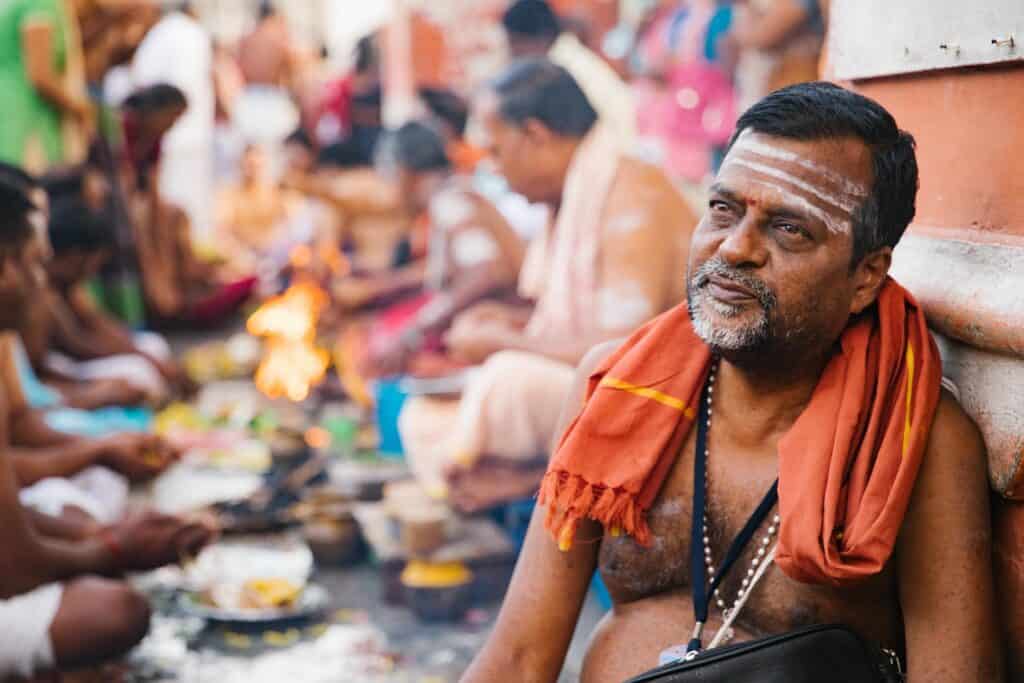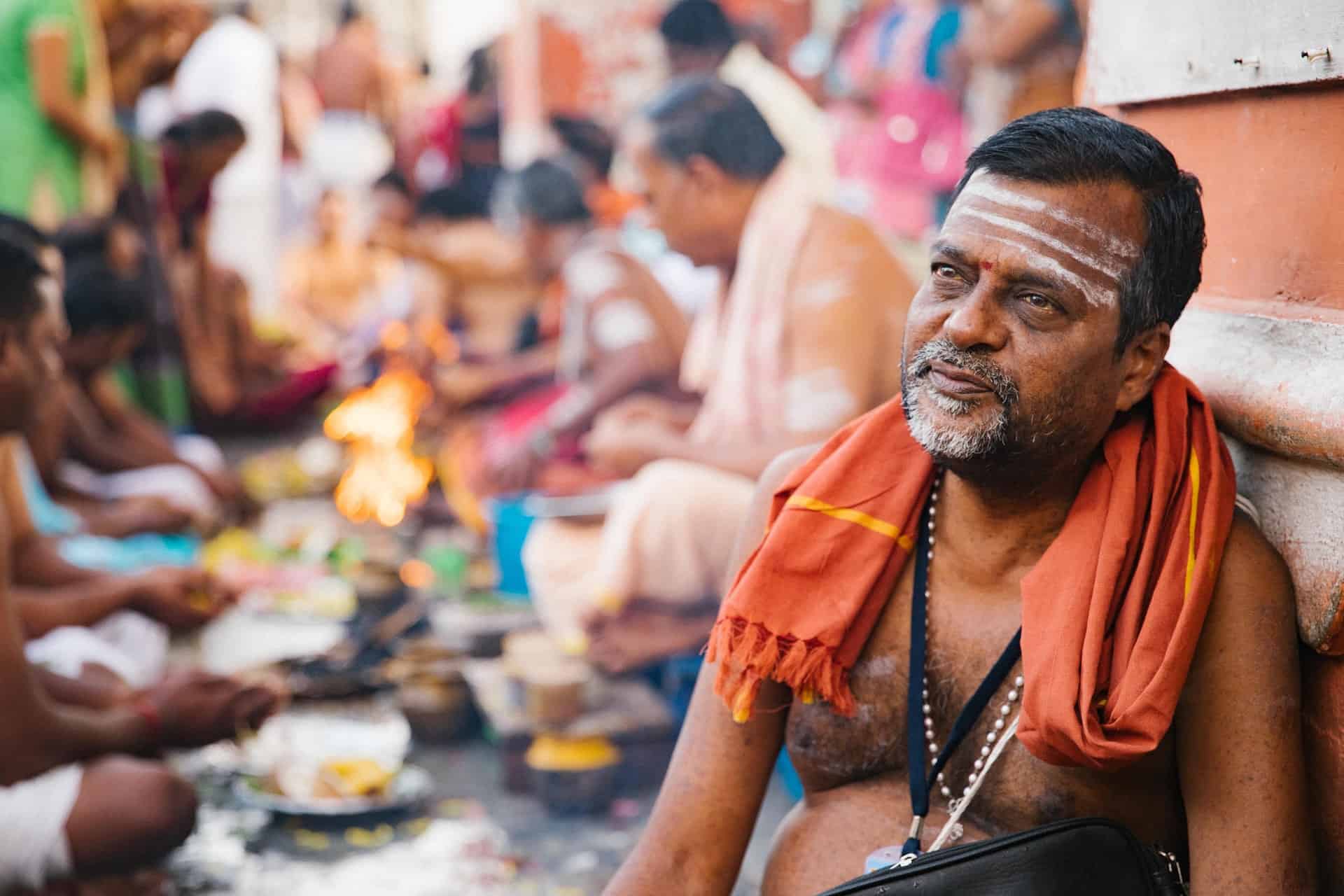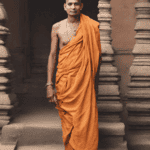Hinduism is a religion that considers sacredness and purity as a very vital part. And so their practices of worshiping God has its own set of rules and norms.
The person who performs the activity of worshiping the Hindu God in the temples is called as a Pujari and Purohit or a Priest in English. They are considered to be the mediator between the worshippers (bhakts) and God. Also, these priests are considered to be Brahmins who are the part of the highest-ranked caste and who have been priests since history.

The brahmins have been awarded to put on a sacred thread. They have been considered to be the pure and the caretakers of the Hindu temples. Also, only they can enter into the sacred boundaries of the temple and call on the dirty to be worshipped.
Furthermore, only Hindus are allowed to be assisted by Brahmin priests while completing ceremonies or traditions, although simpler rituals such as offering food could be done without a priest. A variety of intercessory priests, holy men, and professors conduct and help in performing with the ceremonies. The Brahmin customarily has not conducted ceremonies for the lower castes. In rural regions, local headmen mostly take control of the ritual performing.
Nowadays mostly the Brahmins only perform rituals to the gods for the higher-ranked caste and gods. Whereas the lower caste priests are only allowed to perform rituals for the low ranked gods. Also, the duties of rituals are performed as hobbies and jobs now, and conducting priestly responsibilities is rarely seen.
Who are Brahmins?
The Brahmins are considered to be the highest-ranking caste committee and are the prime of the varna structure even above Kshatriyas, Vaisyas, and Sudras castes. Brahmins have been priests since history in temples and families and have also known to be well educated and knowledgable who have also had high degrees with possession and wealth.
Several Brahmins have served as teachers, writers, landlords, and also as government clerks to date. Now in this era, the brahmins are engaged in many careers. And most of them fulfill their priestly responsibilities in part-time.
They are asked to protect the high status of purity and learn Sanskrit and different languages and also, have an understanding of the Hindu ritual system. They give up on labor and mostly have very delicate hands that testify for it. Also, they refrain from eating onions, ginger, and potatoes as they rise from the polluted surface. As far as caste is considered they even consider themselves superior to the Vaisya which was Gandhiji’s caste. The needy and common Brahmins have looked upon them as to be superior to kings in ancient history. The kings who are concerned with the Kshatriya caste of fighters and nobles, which is considered to be below the Brahmins caste. In the Aryan history the brahmins have been proven to be superior to the Kshatriyas politically as well as religiously.
Brahmins have protected their strength over the years by making them the only existing caste allowed to learn Sanskrit.
Now the brahmins and other upper castes are said to be Forwards. The introduction of quotas for special benefits for the lower caste now brahmins have made their way to leave India and find their future in other countries.
Why do Brahmins and Purity go hand in hand?
Firstly, they are members of the greatest castes of priests. Brahmins are mainly vegetarians and resist eating meat which is an intern the output of brutality and demise. Although, some Maharashtrian and Bengali brahmins eat non-vegetarian like fish. The High-ranked Kshatriyas which is the Warrior castes commonly intake non-vegetarian diets for it is considered to be relevant for their beliefs of bravery and physical power.
When a Brahmin is born of Brahmin parents they maintain his ingrained righteousness if he rinses and dresses appropriately, and consume a vegetarian diet only and eats feasts cooked by someone of proper rank, and keeps himself away from any kind of physical involvement with somebody he is not married to (they are only allowed to involve into such activities to continue their inheritance). These sacrifices count him accountable to be pure in the sight of God. Also if a Brahmin occurs to get into physical touch with a polluting material, he can cleanse this by cleansing and addressing himself with clean clothes. Yet, if any Brahmin has been found to dismiss his purity be eating the meat of performing against any of the strict measures he needs to follow, then he has to go through a number of rituals to regain his purity and innocence before performing any worship duties.
The Sacred Thread – Janeu
The thread is a reminder of big status in the caste system in India where only the Brahmin and Kshatriya castes are allowed to put it on. It is made up of three cotton strings that are twisted and are worn over the shoulders and across the chest and under the opposite arm. It signifies that the wearer of the thread is born twice. The first birth is by his mother and the second is through a new man in Hinduism (it is recognized by many names, differing by area and society, comprising janai, janeu, yajnopavita, lagun, yagyopavit, zunnar, and yonya)
The three strings signify the mind, body, and the acts of the person. And the threads coiled together portray that the person wearing it has control over all the three in his life. Yep, brahmins wearing the thread are expected to keep it clean and pure for it is considered to be sacred. It is believed that if the thread comes in contact with any lower caste or women who are menstruating it should be replaced by a new so that it is not polluted and is sacred. The wearer should take the utmost care of it making sure it doesn’t get dirty even while performing some health-based rituals. The sacred thread ritual is executed to make sure that the ceremony goes on even to their ancestors. Earlier, a seven years old boy would get his head shaved, the body properly cleaned and the nails of his fingers and toe cut off. When the head was shaved a small part of hair would be left out in the center signifying him to be a Hindu boy. Before starting with the ceremony it was made sure that the boy had eaten a meal which had no impurity in it (that is no garlic, onions, potatoes, or meat). When the ceremony is healthy in the temple the purohit or pujari reads out scriptures and also invokes Vishnu before putting on the threads over the boy’s neck. Once the ceremony is completed the boy can completely wear the thread and is considered to be a man. He is permitted to eat with other men and also gets a set of new responsibilities like them.
Hinduism is a religion that has been very particular about every little detail for years. There have several reasons for the discrimination of caste and also the distribution of responsibilities. The sacredness and purity considered to be present in a Brahmin or a Hindu are likely the most as compared to the other casts for the reasons mentioned below. It is believed that one needs to be completely pure and blameless before he can be presentable in front of God. Also, there are certain temples where priests may not just be a Brahmins or a Hindu priest. But according to the heritage and tradition of the culture, it is important for the priest or pujari to be a pure upper-caste Brahmin.

